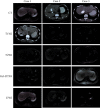Imaging Diagnosis of Primary Liver Cancer Using Magnetic Resonance Dilated Weighted Imaging and the Treatment Effect of Sorafenib
- PMID: 35799672
- PMCID: PMC9256338
- DOI: 10.1155/2022/8586943
Imaging Diagnosis of Primary Liver Cancer Using Magnetic Resonance Dilated Weighted Imaging and the Treatment Effect of Sorafenib
Abstract
Objective: This work explores the application value of dilated weighted imaging (DWI) in the diagnosis of primary liver cancer (PLC) and the effect of sorafenib in the treatment of PLC.
Methods: 88 patients with PLC who were treated in The First Affiliated Hospital of Northwest University from March 2019 to March 2021 were selected and randomly rolled into an experimental group and a control group, with 44 cases in each group. Patients in both groups were treated with transcatheter arterial chemoembolization (TACE), and the patients in the experimental group were treated with oral sorafenib on the basis of TACE. The indicators of complications, short-term efficacy (STE), and long-term efficacy (LTE) of the two groups were observed. All patients received DWI and magnetic resonance (MR) plain scan. The diagnostic accuracy and misdiagnosis rate of the two methods in diagnosing the PLC were compared.
Results: The accuracy, specificity, and sensitivity of MR plain scan were 68%, 88%, and 89%, respectively, while those of DWI were 96%, 95%, and 94.2%, respectively. It indicated that the accuracy, specificity, and sensitivity of DWI in diagnosing lesions were better than those of MR plain scan, especially the diagnostic accuracy (P < 0.05). The objective response rate (ORR) and disease control rate (DCR) of the STE in the experimental group were 30% and 97%, respectively, and those in the control group were 6% and 54.5%, respectively. The experimental group's mean progression-free survival (mPFS) and mean overall survival (mOS) were 12 and 25 months, respectively, while the control group's were 8 and 19 months, respectively. It was concluded that the mPFS and mOS of patients receiving TACE combined with oral sorafenib were much higher than those receiving TACE only (P < 0.05).
Conclusion: DWI and TACE combined with sorafenib had high application value in the diagnosis and treatment of PLC.
Copyright © 2022 Bin Fan et al.
Conflict of interest statement
The authors declare that they have no conflicts of interest.
Figures









Similar articles
-
[Comparison of therapeutics effects of transcatheter arterial chemoembolization combined with iodine-125 seed implantation and sorafenib for the treatment of hepatocellular carcinoma with portal vein tumor thrombosis].Zhonghua Gan Zang Bing Za Zhi. 2018 Apr 20;26(4):298-304. doi: 10.3760/cma.j.issn.1007-3418.2018.04.013. Zhonghua Gan Zang Bing Za Zhi. 2018. PMID: 29996343 Chinese.
-
Sorafenib combined with transarterial chemoembolization prolongs survival of patients with advanced hepatocellular carcinoma.J BUON. 2020 Mar-Apr;25(2):945-951. J BUON. 2020. PMID: 32521890
-
The safety and efficacy of transarterial chemoembolization combined with sorafenib and sorafenib mono-therapy in patients with BCLC stage B/C hepatocellular carcinoma.BMC Cancer. 2017 Sep 12;17(1):645. doi: 10.1186/s12885-017-3545-5. BMC Cancer. 2017. PMID: 28899349 Free PMC article.
-
Is transcatheter arterial chemoembolization plus sorafenib better than chemoembolization plus placebo in the treatment of hepatocellular carcinoma?Tumori. 2021 Aug;107(4):292-303. doi: 10.1177/0300891620945029. Epub 2020 Jul 30. Tumori. 2021. PMID: 32729385 Review.
-
Trans-catheter arterial chemoembolization plus Sorafenib, an unsuccessful therapy in the treatment of hepatocellular carcinoma?: A systematic review and meta-analysis.Medicine (Baltimore). 2020 Jul 17;99(29):e20962. doi: 10.1097/MD.0000000000020962. Medicine (Baltimore). 2020. PMID: 32702836 Free PMC article.
Cited by
-
A novel phosphodiesterase target as a therapeutic approach: inhibiting DEN-induced hepatocellular carcinoma progression.EXCLI J. 2025 Mar 7;24:407-429. doi: 10.17179/excli2024-7941. eCollection 2025. EXCLI J. 2025. PMID: 40166422 Free PMC article. Review.
References
-
- Chong H. H., Yang L., Sheng R. F., et al. Multi-scale and multi-parametric radiomics of gadoxetate disodium-enhanced MRI predicts microvascular invasion and outcome in patients with solitary hepatocellular carcinoma ≤ 5 cm. European Radiology . 2021;31(7):4824–4838. doi: 10.1007/s00330-020-07601-2. - DOI - PMC - PubMed
MeSH terms
Substances
LinkOut - more resources
Full Text Sources
Medical
Research Materials
Miscellaneous

